




















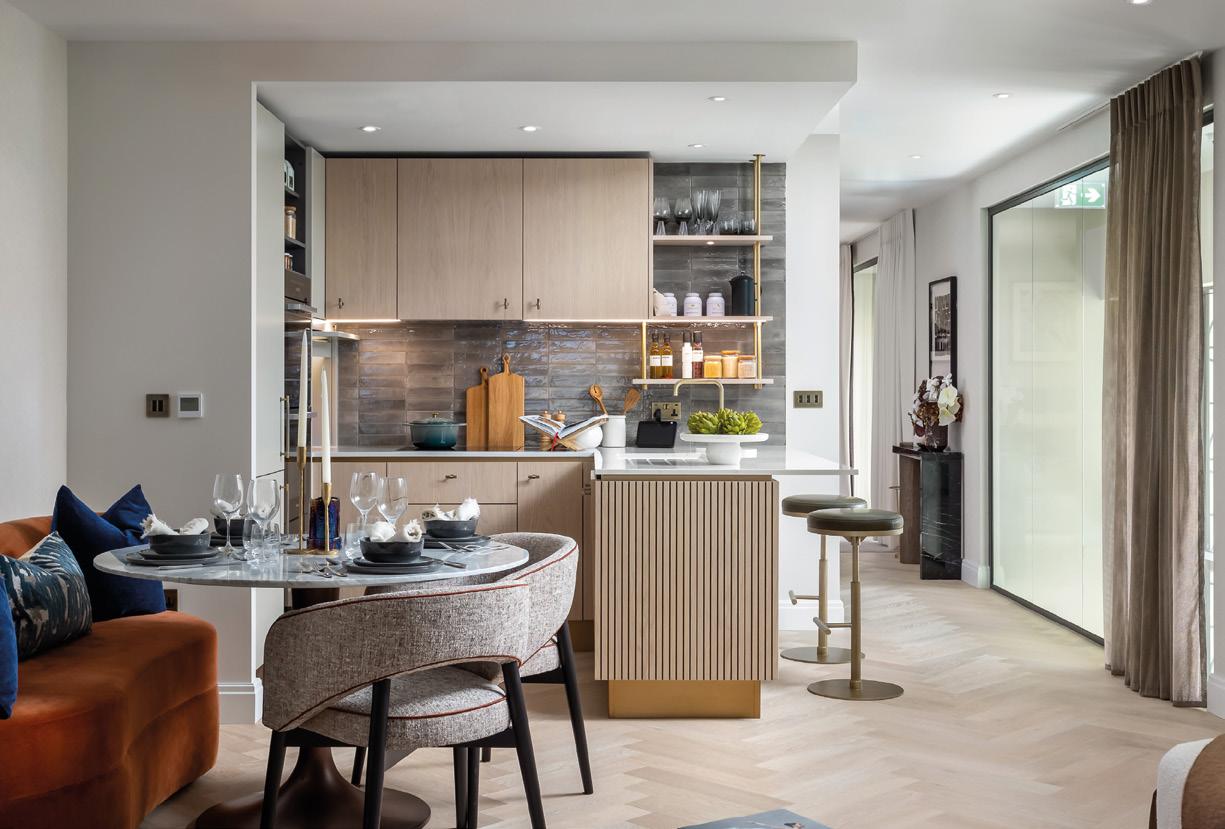






Editor
Maggie Chambers editor@onthehill.info
Editorial Group
Dick Bird, Doro Marden, Phil Cowan, Pam White, David Lennon, Mole on the Hill, Micael Johnstone, Andrew Black
Social Media and Website Editor Jason Pittock
Subeditors
Brenda Stones, Vicki Hillyard
Cartoon
Bridget Grosvenor
Photographer
Sarah Louise Ramsay www.slrphotography.co.uk
Design
John Dillon hello@jwdillon.co.uk
Advertising Sales
Richard Ramsay ads@onthehill.info
Special thanks to all our contributors.
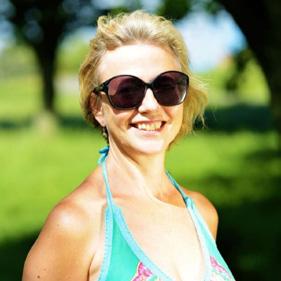
This publication is created by the community and for the benefit of Primrose Hill on behalf of your local charity, the Primrose Hill Community Association (PHCA). All proceeds from this publication go directly to fund the charity. We hope you enjoy.
www.phca.cc
Disclaimer: the views in the magazine are not necessarily the views of the PHCA.
Happy birthday to us! On The Hill has now been running for ten years! In that time, we’ve charted the political rise of the now Prime Minister, hoaxed you one April Fool’s Day that there was fracking on the Hill, and brought you a wide range of characters, events and charitable ventures over the years, in true Primrose Hill style.
Curious to know what the symbol of a tenth anniversary is, I looked it up and discovered it’s tin. By the time this anniversary rolls around, there should therefore be strength, durability and general lack of corrosion, which are all useful qualities in a magazine. A little like the qualities of the Tin Man, only with much more of a heart.
The Primrose Hill Community Association originally intended the magazine to be a guide to publicise local events, but it’s expanded to become what it is today. As well as hopefully providing an interesting read, it’s very much a community magazine and therefore an invaluable resource to garner support for local causes.
We hope you’ll come and support the Book Festival at the Primrose Hill Community Library on 2 and 3 November (see p 25 for details) and the Primrose Hill Lecture Series at St Mary’s, with Andrew O’Hagan on 10 October and Simon Jenkins on 13 November. And for disco enthusiasts, put 16 November in your diary for the Village Disco.
I’d like to thank all the individuals who work behind the scenes on On The Hill: especially those who volunteer on the magazine, our advertisers who support us and keep us afloat, and of course our readers.







By Sanam Lou

Nestled in the middle of Chalk Farm, Primrose Hill and Belsize Park lies a meadow called the Adelaide Nature Reserve. It sits on a stretch of railway embankment, so as you enter and head down the slope you may feel you are trespassing, but encourage you to keep on going. As you walk through the reserve, you’ll notice that this little piece of land provides a home to a large number of tiny and medium-size creatures.
The site has been recognised as a nature reserve since 1984, but for hundreds of years it was a hay meadow. Then in the 19th century, the railway was tunnelled through it. The land is now owned by Network Rail, and leased to the London Borough of Camden for use as a nature reserve. Since 1985, the site has been managed by the Adelaide Nature Reserve Association, and volunteers from Camden’s Green Gym play an important role in ensuring that the reserve remains untouched. Even with it receiving its Local Nature Reserve status in 2011, it is continuously under threat by project proposals in the area, the worst instance being the disastrous HS2.
Dave Lawrence, a retired microbiologist, is now secretary of the Adelaide Nature Reserve Association. He says, “The Adelaide Reserve has 180 wild plant species, 30 different types of trees, 160 various species of insects, 23 species of spiders and 40 bird species. These species are in great danger as HS2 has removed part of the woodlands, and many other nature reserves in the area have already been demolished. It is critical that we continue to preserve the reserve. The benefits of keeping these nature reserves alive are tremendous − to humans, to nature and to our ecosystem.”
In 2019, a global assessment of biodiversity and ecosystem services estimated that a million species are at risk of extinction, many within decades, concluding that “we are eroding the very foundations of our economies, livelihoods, food security, health and quality of life”. The fact that so many species are declining at such a rate – 100 to 1,000 times the natural background rate – has led to the situation being described as the planet’s “sixth mass extinction”. This has Lawrence and members of the Association worried about the future of the Adelaide Nature Reserve.
The reserve offers a small patch of magic, so much so that when you walk through it, you almost forget you are in central London. It is dominated by a south-facing meadow with some adjacent areas of woodland. There are two ponds, one of which has a dipping platform. A circular path runs around the site. A mural, which includes illustrations of site wildlife, overlooks the reserve. Dave Lawrence continues, “Nature is under so much pressure, particularly urban nature. Green spaces like this are so important, particularly along railway lines. They act as green corridors, which means that wildlife can move between different parts of the borough.”
The Adelaide Nature Reserve Association and volunteers from the Camden Green Gym have made a huge contribution to keeping the reserve unharmed. The Green Gym volunteers work hard to ensure that the area doesn’t turn entirely into woodland. As Dave Lawrence puts it, “Volunteers are what keep this piece of land alive and unspoiled. Without them, the site is in great danger. We need volunteers to continue managing the site and fighting to preserve it. Without them, I fear it will all be lost.”
If you would like to visit the reserve, it is open to the public every Saturday and Sunday from 8am to 4pm. Events are held on the last Sunday of the month from 11am to 3pm and at other times by arrangement. Activities have included bird and plant surveying, nature trails, wildlife arts and crafts, badge making, nature quizzes and games and much else.
We are also looking for new volunteers. If you are interested in this role, please email Dave Lawrence at dave.lawrence@uclmail.net.
6 September 1934–3 May 2024
We were all deeply saddened to hear we’d lost the presence of Colin St Johnston in our community. He was the kindest, friendliest, most generous and modest of men, loved by all who knew him.
Colin gave many years of his life to the Primrose Hill Community Association, serving as Treasurer for over twenty years. Under his stewardship the Community Centre made huge progress in terms of what it offered the community, as well as gaining a much sounder footing financially, ensuring the Association could remain a viable and vigorous organisation. During protracted lease negotiations, his master stroke was managing to persuade Camden Council to offer a 25-year lease at a significantly reduced rate, mainly due to the good relationship he had built up with one of Camden’s senior negotiators.
Colin was also instrumental in making sure that Primrose Hill retained its Library. Whilst others within the Community Association were wavering over bidding to take it over, Colin instead wrote to the trustees expressing his opinion that it was their duty to save the Library. The rest is history, and many years later the Primrose Hill Community Library is thriving and cherished.
Colin’s school days were at Shrewsbury, and his great honour was to be Head of School in 1952, Shrewsbury’s 400th anniversary. HM Queen Elizabeth II and Prince Philip made a royal visit for the anniversary, to open the new Fourth Centenary terrace overlooking the town and the river; afterwards, at a select lunch in School House, Colin took his place between the Queen and the Duke! He then won the Heath Harrison Exhibition to Lincoln College, Oxford in 1955, where he read History. There he gained a fine sports record, including a Fives Blue, playing for the Oxford Authentics cricket club and becoming a member of Vincent’s, the Oxford club for sporting blues. He was always a dedicated squash and tennis player.
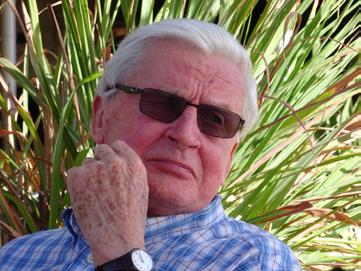
While at Oxford Colin courted Valerie Paget, a history student who had many suitors. They both lived near Burton on Trent, and had first met at St Wystan’s preparatory school in Repton when Colin was eight; they started ‘going out’ together from age sixteen and married soon after coming down from Oxford.
Colin’s distinguished working life started at Booker Brothers, where he was assistant to Sir Jock Campbell, the chairman. After an interlude in British Guiana, he returned to the UK as chief executive of United Rum Merchants. He was then headhunted by Ocean Steamship Company, where he became Chairman of the William Cory Division. For his final job before retirement, he was the Director of PRONED, an organisation for finding, recommending and placing non-executive directors, about which Colin felt passionately.
Valerie meanwhile started her career in advertising, then switched to teaching, becoming a celebrated head of history and the first woman head of department at Westminster School. Together they produced their lovely family of four children, all of them now successful in their own fields, and many grandchildren, to whom Colin was a fond and generous grandfather.
After retirement, Colin continued playing lawn tennis and real tennis at Lord’s, and served on the MCC Committee there. He managed any physical ailments stoically, still managing four flights of stairs every day. Throughout his life, he remained ever cheerful and interested in everyone around him.


A slightly grim Edwardian postcard of Princess Road, looking towards Gloucester Avenue. The houses in the frame are, from left to right, numbers 35 to 63, with a cross at number 53.
A few children pose for the photographer, positioned next to the street light. To the left we see a lady, her back turned to the camera, with a small child. She seems to be looking down into the basement.

The card was posted on 27 July 1927, according to the postmark, to a Miss Spinks in Norwich. The writer, Bernard, thanks his ‘auntie Phyl and uncle J’ for their postcard and birthday present. So it’s Bernard’s house at number 53, and he’s marked the two windows on the first floor as ‘our room’. He ends his message with ‘Fondest love to all and kisses’.
@old_primrosehill_postcards

It’s hard to believe it is ten years since the first On The Hill magazine landed on the doorsteps of Primrose Hill. To mark the occasion, we shall be inviting On The Hill connections to a celebratory event at the Community Centre in October. We’d like to thank Maggie Chambers and the OTH team past and present for all their brilliant work over the years. (See more on p12.)
We are looking forward to welcoming you to the PHCA Annual General Meeting on Thursday 17 October, with a very special local guest speaker. Formalities start promptly at 7pm with the guest speaker starting around 8pm. Do come and enjoy a drink with your neighbours.









In this edition you’ll find more details of the Book Festival which takes place at the Primrose Hill Community Library on 2 and 3 November. Organiser Pam White has again come up trumps with an amazing line-up. You can book tickets on the Library website: www.phcl.org
Other activities in November include a talk on ‘Artists and their Studios in Primrose Hill in the 1960s and ’70s’. Paul Huxley RA and Michael Craig-Martin RA will be joined by Jeremy Lewison, former Director of Collections at Tate and author of a recent monograph on Huxley, to talk about their time as artists in Primrose Hill. The talk will take place on Thursday 14 November at the Primrose Hill Community Centre at 7.30pm. (See more on p13.)
On 16 November we hope you’ll come to our popular Village Disco: paid-up PHCA members will be offered tickets first, and then it will be opened out to others if there are any remaining.
There is also a regular Memory Singing Circle for people with memory loss and other neurological conditions and their carers. It takes place on Tuesdays at the Community Centre at 3pm
Finally, we’d like to say a huge thanks to Dom Hua who has left her roles at the Community Centre and Library to work for Bloomsbury Publishing. She has been a joy to work with and we wish her well in her new career. (See more on p26.)

Locally based in Primrose Hill, PillarCare's friendly, experienced team have been helping people live as independently as possible in their own homes for over 20 years.
Please speak to Matt or Chloé to find out more









By Dick Bird
Ten is a good age to be: old enough to know what’s what, but still with exciting times to come. But a tenth anniversary seemed very unlikely when On The Hill first hit the doormats of Primrose Hill. In 2013 the Community Association had been thinking about the nature of community spirit. You can’t see it, you can’t measure it, but you know if you’ve got it. And Primrose Hill has it in smug spades.
It helps that history and geography give us a lot to be proud of. It helps that a culture of activism has embedded here. Not necessarily just in gentrified recent times. The Daily Worker of 6 May 1957 reported that the Chalk Farm Tenants and Residents Association, having organised a Clean Air Week, had petitioned the Queen about the unacceptable health hazards of living with smoke and particles from 28 engines under steam for many hours from Euston. When this was passed to the Minister of Transport, a second letter went off to the Palace claiming the first had gone into a wastepaper basket. Don’t mess with Primrose Hill, then or now.
But for neighbours to join together, whether for quiz nights, yoga or campaigns, they need information. Perhaps because the Community Association existed before it had a building, it has always had a wider brief than just the users of the Community Centre. But how to be in touch? A database of email addresses receiving weekly bulletins was mooted. Then into the discussion swept a new resident, Janet Reuben, fresh from working on establishing Hull as a City of Culture: “We can do better than emails!”
A small group of volunteers formed and planned a simple template: a monthly magazine about Primrose Hill people and issues, professionally produced but run and written by volunteers, delivered free to every household, paid for by advertisements. Ten years later that remains the plan, though issues are no longer monthly. Most of the original volunteers remain, though are older. Step forward anyone reading this who would like to be involved!
There were of course siren voices. “Keeping it going will be harder than starting it.” “You’ll run out of topics to write about.” “People will write rude letters.” Not so. Quickly residents liked seeing places and faces that they sort of knew, basked in a little reflected glory, and enjoyed a gentle read about the issues and campaigns that self-respecting Hillies should care about. On The Hill has become yet another reason to like living here.
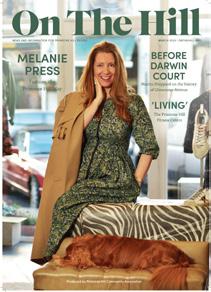


The first edition in November 2014 had two deliberate features. One was a profile of Wafa Abou El Hassan, then the front-of-house manager of Shepherd’s supermarket; the other was a little-known aspect of a famous local resident, the broadcaster Matthew Wright. The former was interesting because this was someone superficially well known to many locals, and in the nicest way an ordinary resident. The latter was a celebrity, and however sniffy and high-minded we might be about that, secretly which of us can resist a little stardust? Especially the classy, intellectual stardust our neighbourhood attracts. You know who I mean: not footballers. Both the unrecognised and the recognised neighbours are important; and the schoolkeeper who might be featured in On The Hill may not be written about elsewhere.
Also featured in the first edition was a map of the area, so amateurishly drawn that it did indeed attract rude letters and was quietly withdrawn. But we introduced a What’s On directory of local events and activities and how to participate, that has continued and grown. It’s a nightmare to produce accurately, but is undoubtedly a valued service. It never fails to illustrate the eclectic nature of our interests, which ranged in 2014 from music based on epic 19th-century whaling to a ‘Love your local leaves’ tree trail. Then there were pictures of dogs − as now, just smaller now. There was a joke about HS2: residents digging out their basements so that a train could stop at their house. Time may have moved slowly since − but rather faster than HS2. And a report of a legal challenge to a planning application for Utopia Village, poignantly echoed today.
So, over the years, On The Hill has chronicled the life and times of our patch. Now online as well, it has raised issues, smiles and eyebrows. Of course there have been bumpy moments, artistic clashes, impecunious periods. But if we are better informed about what is going on, if we can join with our neighbours in stretching our lives and interests, if in just a modest way the people who live in Primrose Hill have a sense of ownership for it and each other, well then, that’s community spirit and On The Hill is on the button. Here’s to the next ten years and beyond.
Now where did you put my draft obituary? Bounced? For a recipe?!



By Simon Jenkins

I wonder how many residents of Primrose Hill stop to ask why it looks as it does. Why is that door or window or roof as it is? The appearance is that of a familiar London suburb developed from 1845−75. Facades are Italianate, of brick and stucco, arranged with a grid of streets and mews crossed by two former country tracks and a later railway. The classicism is displayed discretely, in the occasional pilaster and scroll, porch and window pediment: the touch of ancient times that gave class to early Victorian speculative building. Why then did the Hill’s two churches show no trace of the classical style? Its earlier neighbours to the south and west, St Marylebone and St John’s Wood, were starkly Grecian. Yet St Mark’s of 1851 is Victorian Gothic and St Mary’s of twenty years later is red-brick neoGothic. The answer is the Victorian battle of the styles: Italianate for living, Gothic for worship. Londoners in the 19th century knew the language they wanted around themselves, and for which purpose. It is the language they bequeathed to the area’s residents, probably in perpetuity.
British architecture − the style of its built environment − has always been subject to fashion, often to no more than transient whim. Yet few now speak its language and comprehend its meaning. We used to know what we liked and disliked. The parishioners of St Peter Eaton Square came near to rioting when it was rebuilt in 1837 classical not Gothic.
Theorists such as Soane, Pugin and Ruskin handed down judgements with theological certainty. Just as 18th-century Londoners took classicism to their hearts, so Victorians took to Gothic and then to Queen Anne. The result is the vagaries of estates across every inner London suburb, depending on the decade in which they were built. By the Edwardians, civic baroque fought suburban Arts and Crafts. In the 20th century, the suburban explosion pitted neo-Tudor against neo-Georgian.
After the Second World War, a great revolution occurred. For some thirty years modernism captured the attention of town planners. It declared the existing city to be obsolete and unsuited to the motor car. It needed demolition. All should be rebuilt, preferably in the style approved by the French architect, Le Corbusier. Extensive demolition proceeded in inner cities such as Glasgow, Liverpool, Manchester and East London.
The influence of this movement was, for a while, phenomenal but is now little noted. I find few are aware of the planned destruction of much of Britain’s inner cities. London’s plan called for the demolition in the West End of Whitehall, Piccadilly Circus, Covent Garden and Soho. The Blitz was timid in comparison.
The result was the counter-revolution of the conservationist 1970s. The successful saving of Covent Garden led to the rescue of Piccadilly and Carlton House Terrace. This was followed by the abandonment of the Motorway Box, which would have driven an overhead motorway across Camden and Islington. Old London was saved by conservation areas. Even so, planners in league with developers and their architects continue to want their visions given priority over consultation and conservation.
The problem is that urban change is a conversation of the deaf. The language in which London architecture was discussed in the 18th and 19th centuries is largely left to architects. It is as if only musicians could discuss music. We may dislike brutalism, or concrete and glass, or high rise, or we may not, but we lack the words to say why.
I believe architecture should be taught as are other art forms. It matters, just as countryside and air pollution matter. Eyes should be opened to issues of style. We should not leave our surroundings in the hands of others. We need to speak architecture.
Simon Jenkins’ Short History of British Architecture: from Stonehenge to the Shard is published in October.
On Wednesday 13 November at 7pm, he will be speaking at the Primrose Hill Lecture Series in St Mary’s Church.
Tickets are £15 / £10 concessions/online and are available from eventbrite.co.uk or from Primrose Hill Books.
Since the 1960s, Primrose Hill has been quite a centre for visual artists. Often they have occupied previous semiindustrial sites, like Butcher’s Yard, a former plasterer’s depot on Fitzroy Road, which at various times housed Stephen Buckley, Michael Craig-Martin, Rita Donagh, Paul Huxley and Philip King, and is now redeveloped as Chalcot Yard. There are also purpose-built studios like the nineteenth-century Primrose Hill Studios, occupied by John Hoyland and Patrick and Pauline Caulfield.
On 14 November, Paul Huxley RA and Michael Craig-Martin RA will be joined by Jeremy Lewison, former Director of Collections at Tate and author of a recent monograph on Huxley, to talk about their time as artists in Primrose Hill. CraigMartin’s major retrospective at the Royal Academy will run concurrently.
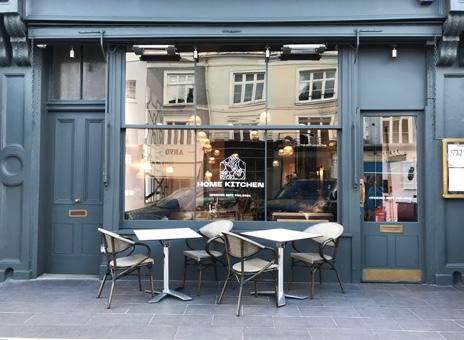
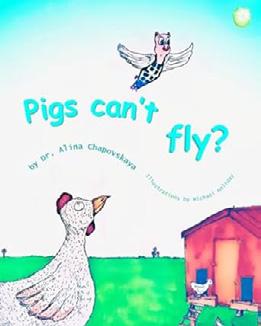

The founder of the Primrose Hill Business Centre, Frank Carson, has passed away at the age of 92. Frank was a well-loved figure in Primrose Hill. He founded the Primrose Hill Business Centre over forty years ago, making it one of the longest running businesses within the community and also one of the first co-working spaces in London. The business continues to be run by Frank’s family. In 2020, On The Hill ran an article on Frank’s life and the business community he started, which can be found on our website at www.onthehill.info/2020/01/the-primrose-hill-business-centre

In the summer, we said farewell to local restaurant Odette’s, which had been situated on Regent’s Park Road since the 1970s. The replacement is Home Kitchen, launched by Andrew Fishwick (formally from the Truscott Arms) who has opened ‘the world’s first fine dining restaurant to be staffed by homeless people in London’. Two-time Michelin star winner Adam Simmonds is to be the Executive Chef.
The plan is to extend the idea to other cities with significant homeless communities.
@homekitchenlondon
Alina Chapovskaya is a local self-published author who has been living in Primrose Hill since 2008. She has just released her first children's book on Amazon, called Pigs Can’t Fly It is a rhyming story about a little pig who wanted to fly but nobody believed in; she never gave up, and inspired others along the way to pursue their dreams. Literary ambition runs in the family, as Alina’s son took part in On The Hill’s short story competition during lockdown.
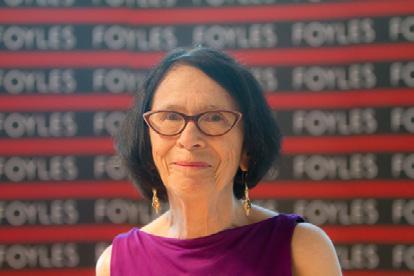
Local author Barbara Bisco has died, aged 87. Barbara wrote three books: A Taste for Green Tangerines Night of the Water Spirits and Tiger With A Human Soul. She was often at the top of Foyles’ bestseller list at launch, and was a frequent figure at author events in North London. She made the area her home in retirement after a peripatetic life with husband Roger Montgomery, living for instance in Indonesia and Thailand, which figured prominently in her novels.
Barbara was also known for her cat Obama, who followed Barbara and Roger on their walks and often invaded local homes and businesses. Barbara is survived by husband Roger, daughter Jasmine, grandson Rafe and the cat Obama.
Residents were understandably disgruntled this summer when a planning scheme was passed which will add three massive power plants to Utopia Village, which is currently undergoing redevelopment. Their purpose is unclear, but they are predicted to cause a constant loud noise, like low-flying aircraft. Objectors conducted a well-organised campaign, including a petition to reject the proposal, but in spite of their attempts it has been approved.

TUESDAY 3 OCTOBER
Film Show
The Princess Bride is a timeless tale of adventure, romance and wit, brought to life by an outstanding ensemble cast.
Directed by Rob Reiner and based on William Goldman’s beloved novel, the film stars Cary Elwes and Robin Wright. PHCL. Doors open 7.15pm. £8 including a glass of wine. Tickets at phcl.org/ filmshow.
WEDNESDAY 16 OCTOBER Book Club
Every third Wednesday of the month. PHCL. 7pm. Check website for details of the book. Free.
FRIDAY 18 OCTOBER
Jonathan Blake in concert
Jonathan Blake is an independent singer-songwriter whose influences – Frightened Rabbit, The National and Bon Iver – are evident in his raw, emotive, heart-on-his-sleeve lyrics. Expect passionate vocals, infectious loop-pedal singalongs, and an eclectic mix of covers ranging from the 1980s to the 2020s. PHCL. Doors open 7pm. £5 online, £6 on the door. Tickets at phcl. org/gig.
SATURDAY 19 OCTOBER
Feldenkrais with Ana
The Feldenkrais method offers a more fluid, skilful, easy way of moving which promotes a sense of confidence and wellbeing. Each month focuses on a different theme. PHCC. 12.45−2.45pm. £25. More details at www.feldenkraiswithana.com, or contact feldenkraiswithana@ gmail.com.
FRIDAY 25 OCTOBER
Last Friday Bar − Curryoke
The Primrose Hill Community Bar is open on the last Friday of each month. This is a chance to meet neighbours over some discounted drinks and play some pool. This month we’ll be hosting ‘Curryoke’, so come down to the Community Bar for some delicious curry and karaoke. PHCL. 6.30−9.30pm.
MONDAY 28 OCTOBER TO FRIDAY 1 NOVEMBER
Circus Glory camp
Learn aerial and floor circus games at this half-term camp. All levels welcome; no experience necessary. PHCC. 10am−3pm. More info: www.circusglory.com.
MONDAY
Ready Steady Go Beginners
A gentle introduction to preschool activities for ages 1–2 years. PHCC. 9.15–11am. Contact: 020 7586 5862.
Ready Steady Go
Pre-school education and activities for ages 2–3 years. PHCC. 9.30am–12.30pm. Contact: 020 7586 5862.
Rhyme Time
Library Rhyme Time for under 5s. PHCL. 11–11.45am. Suggested donation: £2. Contact: 020 7419 6599.
Hartbeeps
Multi-sensory music movement and drama classes for infants and toddlers. PHCC. 2–5pm. Contact clarelouise@hartbeeps.com.
Circus Glory
Trapeze for ages 2½–16. All levels welcome. PHCC. 2–7.15pm. Contact Genevieve 07973 451603.
TUESDAY
Monkey Music
Music and play for children under 5. PHCC. 9.25am–12.10pm. Contact: 020 8451 7626.
Ready Steady Go
Pre-school education and activities for children aged 2–3 years. PHCC. 9.30am–12.30pm. Contact: 020 7586 5862.
Ballet
Introductory ballet sessions for children, using storytelling and imagery to teach the basics of dance. PHCL. 10–10.45am. Suggested donation £2. Contact: lilykourakou@hotmail.com.
Hartbeeps
Multi-sensory music movement and drama classes for infants and toddlers. PHCC. 2–5pm. Contact clarelouise@hartbeeps. com.
Chess Club
Every other Tuesday. PHCL. 6.30pm. Free and open to all ages and abilities. Check Library website for more details
WEDNESDAY
Ready Steady Go Beginners
A gentle introduction to pre-school activities for ages 1–2 years. PHCC. 9.15–11am. Contact 020 7586 5862.
Ready Steady Go
Pre-school education and activities for ages 2–3 years. PHCC. 9.30am–12.30pm. Contact 020 7586 5862.
Ready Steady Go ABC
Exploratory play, singing, dance and stories for babies and toddlers aged 6–18 months. PHCC. 11.30am–12.30pm. Contact 020 7586 5862.
Circus Glory Trapeze for ages 2½–16.
All levels welcome. PHCC. 2–6.45pm. Contact Genevieve 07973 451603.
Primrose Hill Children’s Choir Fun songs and games for ages 5–11. St Mary’s NW3 3DJ. 4.10–5.10pm. 1st time free, then £10. Contact: maestromattheww@yahoo. co.uk.
THURSDAY
Karate & Stretch
Build strength, flexibility and coordination. Suitable for all. PHCL. 9.30–10.30am. More information at shiranamikai. co.uk.
Ready Steady Go
Pre-school education and activities for children aged 2–3 years. PHCC. 9.30am–12.30pm. Contact: 020 7586 5862.
Mini Mozart
Musical story time. PHCL. 9.30am–12pm. Book at: www.minimozart.com.
First Class Learning English and Maths tuition. PHCL. 3.30–6pm. Contact: 020 7966 484 568.
Catherine’s Ballet
Nursery and primary ballet classes for ages 3–7 years. PHCC. 4–5.30pm. Contact 020 8348 0262, info@ chalkfarmschoolofdance.co.uk or chalkfarmschoolofdance.co.uk.
Beginners’ Bridge
Free Bridge classes for ages 9+. PHCL. 5−6.15pm. Courses of 6 free lessons available; contact jojarrold@gmail.com.
FRIDAY
Ready Steady Go
Pre-school education and activities for children aged 2–3 years. PHCC. 9.30am–12.30pm. Contact 020 7586 5862.
Circus Glory
Trapeze for ages 2½–16. All levels welcome. PHCC. 2–7.15pm. Contact Genevieve 07973 451603
SATURDAY
Club Petit Pierrot
Fun French lessons for babies and children. PHCC. 9.45–10.30am, 1–3 years old; 11–11.45am, 2–4 years old. Contact 020 3969 2642, www.clubpetitpierrot.co.uk.
Perform
Drama, dance and singing for children 4–12 years. St Paul’s CE Primary School. 9.30–11am (4–7s) and 11.15am–12.45pm (7–12s). Contact: 020 7255 9120 or enquiries@perform.org.uk.
Tales with Tracey
A fun and educational session featuring a well-loved children’s book, enhanced with props, expressive character voices, interactive storytelling and singing for under 5s. PHCL. 11am. £3.
SUNDAY
Perform
Drama, dance and singing for children 4–12 years. PHCC. 10am–11.30am (4–7s) and 11.30am–1pm (7–12s).
MONDAY
Board Games
Come along to the Library for our board game evening. Bring your own or join in with one that we have. PHCL. 6pm. Free.
Chilled Strings
Beginners’ orchestra rehearsals. PHCC. 6.30–8.30pm. Contact sueandhercello@gmail.com.
Primrose Hill Choir
Love to sing? All styles of music, all levels welcome. PHCC. 7.30–9.30pm. Contact: maestromattheww@yahoo.co.uk.
Choir: Voices on the Hill A community choir singing soul, blues, pop, jazz and classic songs. Everyone welcome. PHCL. 7.30–9pm. £10 per session. Contact: voicesonthehillchoir@gmail.com.
TUESDAY
Pilates
Dynamic sessions 10.15–11am; gentle sessions 11.30am–12.15pm. PHCL. £15 per class, £120 for 10 classes.
Contact patricia-pilates.com.
Laban
Workshops based on Rudolf Laban’s analysis of movement, for exercise and fun. All levels welcome. PHCC. 12.30–1.30pm. £10 per session (£5 concessions). Contact jennyfrankel.laban@gmail. com.
Zumba Gold
Zumba class for seniors looking for a fun, modified low-intensity workout, made easy with simpleto-follow steps. PHCC. 2.30–3.15pm. Free. Check PHCA website for details.
Memory Singing Circle
Singing and socialising sessions aimed at people with dementia or other neurological conditions and their carers. PHCC. 3–5pm. Check PHCA website for details.
Morris Dancing Class
Learn Morris dancing. All welcome, no experience required. CSH. 6.30pm. Book online.
Chess Club
Every other Tuesday. Free and open to all ages and abilities. PHCL. 6.30pm. Check Library website for more details.
Fellows Singers
A local chamber choir with a wide repertoire across the centuries, styles and languages. PHCC. 7.30−9pm. Contact 07901 555 785 or jeremy@jeremylewison. co.uk. More information at fellowssingers.com.
Let’s Salsa
Salsa classes. PHCC. Beginners 8−8.45pm, beginners/improvers 8.45−9.30pm, social dancing/ practice 9.30−10pm. £10 for 1 class, £15 for both. Contact derrick@encantado.co.uk or 0790 3363773.
WEDNESDAY
Wellbeing Café
Café space and warm bank serving delicious homemade soup and cake, teas, coffees, jacket potatoes and more. PHCC. 10am–2pm. Pay what you can.
Open House
A regular activity (film, talk, performance) followed by tea, cake and chat. PHCC. 2–4.30pm. Free.
English Folk Dance Club
Fun for dancers of all abilities and none. No partner needed. PHCC. 7.15–10pm. Contact camdenfolkdance@yahoo.com.
Yoga
Renata teaches breath and alignment-based yoga, aiming to foster strength and mobility, while inviting a quality of mental spaciousness and ease. PHCC. 6–7pm. More info: renatabittencourtyoga.com.
London Sound Project Choir
A friendly community-led choir in North London, performing contemporary songs with a pro band, open to all (18+). PHCL. 7.15–9.15pm. More info: ldnsoundproject.co.uk.
Silver Swans Ballet Ballet classes for over-55s. PHCC. 11am–12pm. Contact: katie@primrosehillballet.co.uk.
Gentle Pilates
Gentle but effective Pilates class. PHCL. 12.45–1.45pm. £15 per session.
Contact jane_seal@hotmail.com.
Narcotics Anonymous Support for people with narcotics problems. PHCC. 1.30–3.45pm. Free. More information via NA helpline 0300 999 1212.
Primrose Hill Community Orchestra
A symphony orchestra for all strings and woodwinds. PHCC. 2–4pm. £10. Contact sueandhercello@gmail.com.
Bridge Club
Beginners’ session 5−6.15pm, advanced session 6.30−8pm. PHCL. Contact jojarrold@gmail. com.
Life Drawing
All levels welcome; friendly group. Please bring your own materials. PHCC. 6.30–8.30pm. £12 card, £10 cash. Follow on Instagram @lifedrawingph. Just drop in or sign up online at meetup.com/ Primrose-Hill-Life-DrawingLondon.
English Country Dancing Class
Learn English country, ceilidh, barn dancing, and related social folk dance styles from further afield. All welcome, no experience required. CSH. 7.30pm. Book online.

FRIDAY
Aerial Pilates
Improve strength and flexibility through movement with the support of an aerial sling. PHCC. 10–11am. Contact: circusbodies@ gmail.com.
Chair Yoga for Seniors Chair yoga. 2.45–3.45pm. Free. Register at phca.cc.
London Classical Choir Great music, regular concerts for the homeless with London Classical Orchestra. Rehearsals near Chalk Farm, every second Friday, 7.30−9.30pm. £10 (£5 concessions). See londonclassicalchoir.com for location and dates.
SATURDAY
Primrose Hill Market St Paul’s School playground, Elsworthy Road, NW3 3DS. 10am–3pm. Contact www. primrosehillmarket.com.
Narcotics Anonymous Support for people with narcotics problems. PHCC. 5.30–7pm. Free. More information via NA helpline: 0300 999 1212.
SUNDAY
Sunday Bar
Primrose Hill Community Bar, a chance to meet neighbours over discounted drinks and play pool. PHCC. 12–3pm.
Primrose Hill Community Centre (PHCC) 29 Hopkinson’s Place (off Fitzroy Road), NW1 8TN Contact: 020 7586 8327, info@phca.cc www.phca.cc
THURSDAY
Primrose Hill Walks
Occasional guided walks through Primrose Hill, Regent’s Park and surrounding areas, sometimes with themes. Meet by the entrance to the Hill, on the corner of Primrose Hill Road and Regent’s Park Road. 10.30am–12pm. Free. Check PHCA website for details.
Primrose Hill Community Library (PHCL) Sharpleshall Street, NW1 8YN Contact: 020 7419 6599 events@phcl.org www.phcl.org
Cecil Sharp House (CSH)w
2 Regent’s Park Road, NW1 7AY Contact: 020 7485 2206 www.cecilsharphouse.org
By Martin Sheppard

If you have ever visited Primrose Hill Studios, off Fitzroy Road, you will have seen the dazzling list of past residents on the board. They include famous artists, musicians and writers, including JW Waterhouse, Arthur Rackham, Sir Henry Wood and Patrick Leigh Fermor. One name, however, stands out as both exotic and untypical. This is ‘HIH Prince Demidoff, Naturalist, Big Game Hunter and Diplomat, 1868−1941’.
Who then was this Prince and what was he doing in Primrose Hill? The first question is easier to answer than the second. He was His Imperial Highness Elim Pavlovitch Demidoff, third Prince of San Donato, 1868−1943 (the date of his death on the Primrose Hill Studios board is incorrect).
The Demidoffs’ vast wealth was built in the eighteenth century on mining in the Urals. They became the leading producers of iron and steel in Russia, and a major supplier of armaments for its army. They also owned gold, silver and copper mines. Elim Demidoff’s grandfather, who raised a regiment to fight against Napoleon at Borodino, was said to be the richest man in Russia after the Tsar.
In 1895 Elim Demidoff was mentioned as a candidate to be the richest man in world: ‘the wealth of Elim Demidoff is beyond calculation’.
Demidoff was a professional diplomat, serving for six years in the Russian Embassy in London (1894−1900), then in Madrid, Copenhagen, Vienna and Paris. Unusually for a Russian aristocrat, he was an Old Etonian. An Anglophile, fluent in many languages, he was also an all-round sportsman, taking castles in Scotland for the fishing and deer-stalking in the summer, and hunting foxes in Leicestershire in the winter. While living in England, he and his wife, Countess Sophia VorontsovaDashkova, moved in the highest social circles, and were guests at Windsor Castle. His wife was painted by John Singer Sargent in 1896.
Demidoff’s two titles, other than diplomat, were not seen at the time as mutually exclusive. Big game hunters thought that they were naturalists. Their trophies became scientific subjects for measurement and for display in taxidermic collections. The Smithsonian Museum in Washington contains 590,000 preserved specimens of mammals, a figure matched by the holdings of the Natural History Museum in London. Hunters saw no contradiction between their interest in wild animals, especially rare and dangerous ones, and killing them. Probably the most famous big game hunter was President Theodore (‘Teddy’) Roosevelt. He went on a prolonged hunting trip to Africa immediately after leaving office in 1909.
While Demidoff was in London as a diplomat, he lived in Clarges Street in Mayfair. He published his own exotic hunting activities in three books in English, Hunting Trips in the Caucasus (1898), After Wild Sheep in the Altai and Mongolia (1900) and A Shooting Trip to Kamchatka (1904). Reviews of his books were mixed even then. Although the Pall Mall Gazette considered Hunting Trips in the
Caucasus ‘one of the most interesting books of sport and travel which we have come across for a long time’, the Daily Telegraph noted that ‘There is good deal of unpleasant monotony about all records of shooting achievements, the details of which are often calculated to awaken sympathy with the slain rather than admiration of the slayers.’
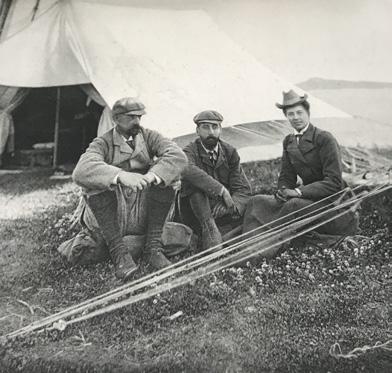
From 1909 to 1920 Demidoff was the tenant of No 6, Primrose Hill Studios, where John Waterhouse had painted many of his greatest works. The reasons for Demidoff’s connection with Primrose Hill Studios are unclear, as he is not known to have been an amateur artist, though the attraction must have been the artistic reputation of the studios. He may also of course have been attracted by proximity to the Zoo, where living animals of species he had killed were to be seen.
As his tenancy was at a time when Demidoff was not based in London, he probably used Studio 6 mainly as a convenient pied-à-terre on his visits to England.
Whether or not he himself was a painter, Demidoff came from a family of major art collectors, going back to his great grandfather. After the defeat of Napoleon in 1815, the family based themselves in France and then in Italy. They combined a life of excess with philanthropy, and with the collection and commissioning of art. Elim Demidoff’s uncle, Anatoly, who had married Mathilde, the daughter of Jerome Bonaparte and Napoleon I’s niece, built an enormous art collection, including works by Vermeer and Velasquez but specialising in painting by leading Romantic artists. It was housed in a specially constructed palace at San Donato, outside Florence. He was made Prince of San Donato by the Grand Duke of Tuscany, a title recognised in Russia by Tsar Alexander II. Elim’s father, Prince Pavel Demidoff, continued the tradition of philanthropy and art collection, giving the funds to complete the façade of Florence Cathedral, on which the family arms can be seen.
Elim Demidoff’s final diplomatic posting was to Athens, as the Russian Empire’s last Ambassador to Greece. He and his wife, who had no children, continued to live in Athens after the Russian Revolution and the confiscation of his Russian wealth.
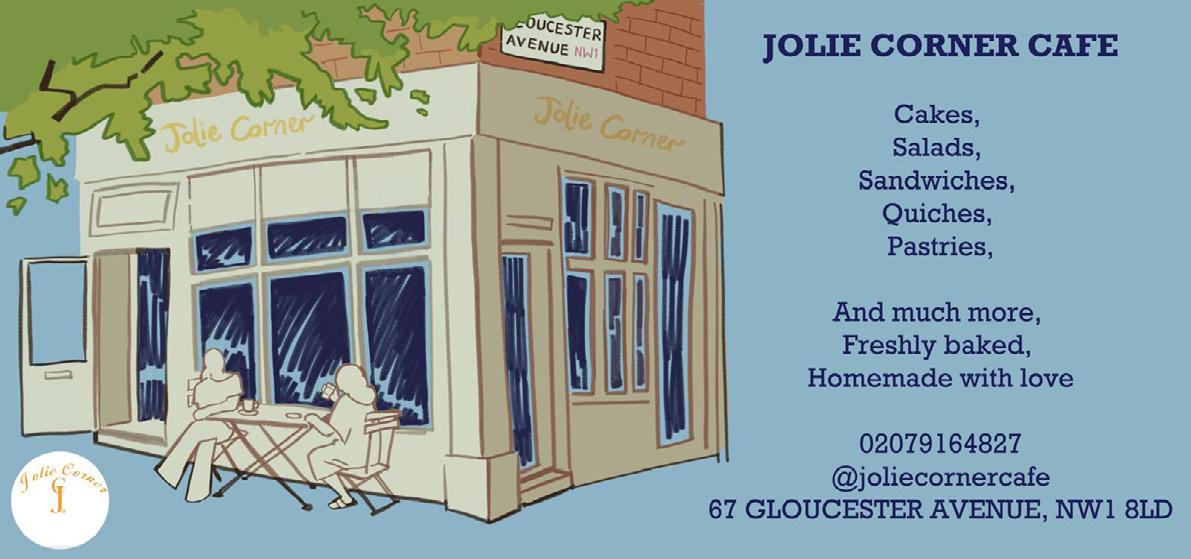
Local teenager Anna Triesman reflects on a childhood spent in libraries
For as long as I can recall, my comfort places have been libraries. Whenever the world seems too much, I seek one out in order to float, untethered, in the endless expanse of collective human thought and experience which words and pictures can convey. Eventually, having read enough to realise that my own concerns are trivial or easily solved, I can allow myself to drift back down to the now modest-seeming corner of the universe in which I was born: Primrose Hill.
My first memory of time spent in a library comes from so long ago that all I recall is a blur of shapes, textures and colours that must have been the well-stocked children’s section of Primrose Hill Community Library. Here, crawling between the brightly coloured carpet and whimsical reading seats, a much younger me discovered the shelves of sensory board books: the ones with flaps and knobs to turn and bits of shiny foil. I realised that the library offered a treasure trove far beyond my favourite books from home: a storehouse could plunder for the rest of my life.
The Montessori school of my nursery years taught me, earlier than many, how to really read. I would spend hours tracing the curves of sandpaper letters, repeating their sounds out loud until I could translate long and once-confusing letter sequences into spoken words. At the age of about four, read a whole picture book at home for the first time; I ran downstairs to my parents on my stubby pre-schooler legs shouting “I’m reading! I’m reading!” They knew before did that this raw enthusiasm for the written word would never fade.
Primary school is often one of the most stressful and terrifying stages of life, although people try to convince you it’s the easiest. As a young, nerdy girl with undiagnosed autism in a school system I couldn’t handle any more than it could handle me, I always tried to sneak off into the book corner that nobody else seemed to use, devouring anything that interested me and plenty that didn’t. I never understood why every classroom had a delectable mini library that was off limits in both lesson times and break times.
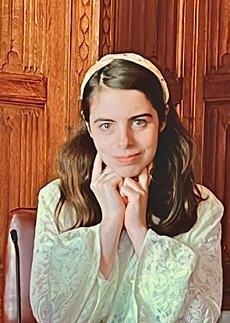
What was the purpose of all those books if nobody was allowed to read them? Were they just there to mock us? To provide a temptation we couldn’t resist, as an excuse to get us into trouble? And accessing the main school library was hardly easier. I would jump up and down with excitement whenever my class had a scheduled library visit.
Once it was time to visit secondary schools in order to decide which one to go to, the quality of the libraries was the only thing remember. I fell madly in love with the Marylebone library the second saw it: all those books on complex topics like philosophy and design history, and plenty of novels I had never heard of before. It was a breath of fresh air after the stifling inadequacy of my primary school library, offering only picture books and over-simplified non-fiction which taught me nothing didn’t already know.
Later, as part of the school’s year 9 award, I started volunteering at the St Marylebone Library whenever I had a free break or lunchtime. I reshelved books, made displays and shared recommendations in the comforting ambience of the library’s eccentric fairy lights. What a contrast to the fluorescent lights and stressful lessons of the school routine.
As I finish writing this, I have just finished a week’s work experience at Swiss Cottage Library, another of Camden’s wonderful public libraries. Working there was a joy beyond measure, whether I was reordering old books (and sneaking the occasional read) in the dusty and mysterious basement reserve section, helping people out at the information desk or munching on cake at an unexpected office party. There I absorbed all that being a librarian could entail, and I now hope to volunteer part-time at my local Primrose Hill Community Library when I’m old enough.
It was through the local library that I discovered Lemony Snicket’s wonderful and offbeat books, A Series of Unfortunate Events a series featuring libraries of all varieties which form a thread that holds the stories immaculately together. As I reflect on the series again, realise how libraries have been central to my past and, if I am lucky, they will go on to shape my future.

Charlotte Claydon on a new initiative that encourages children to cycle to school
I had been meaning to set up a Bike Bus for years, inspired by watching @CoachBalto videos of the original Bike Bus in Portland (I worked on the Obama campaign with him in 2008). With my older daughter too big for my cargo bike, needed to get her cycling independently, and this was the obvious first step.
A Bike Bus is a simple idea: children and parents cycle together to school. There’s safety in numbers (cyclists are much more visible en masse), but even better: endless joy. We play music, we ring our bells, sometimes we have bubbles. The school run as a Bike Bus is suddenly fun for children.
We did a trial run in March with five kids cycling. We now hover around 15 children cycling independently to school, with a few more in the back of cargo bikes. That’s 15 fewer cars on the way to school. And now that we’re better established (and wonderfully supported by Camden Cyclists and Flying Dutchman, who are experienced marshals), parents can drop their children with us and take it in turns to help with the Bus.
We started with just St Christopher’s, but have now added The Hall, Sarum Hall, Trevor Roberts and The Cavendish schools (that’s on our reverse leg!). We are keen to add more.
We meet every week at 7.30 am on Chalk Farm Bridge. We leave promptly at 7.45 am (the traffic becomes noticeably heavier at 8 am). Our route takes us up King Henry’s Road and Primrose Hill Road, before a Trevor Roberts contingent leaves us on Fellowes Road. The rest of us head up to St Christopher’s, then back to The Hall, Sarum Hall and finally The Cavendish.
We started with established cycling families, but now a few of the children have bought their first bike so that they can join in the fun. Several children cycle over from Maida Vale and Kensal Rise so they can enjoy the Bike

Bus for their final leg (although quite a detour!). This is a fun, practical, time-saving way of increasing children’s independence and sense of community.
Studies show that even 20 minutes of exercise make children better able to learn. Our main journey from Chalk Farm Bridge to St Christopher’s takes around 11 minutes − not really enough time for a proper work-out, although at a gentle incline some children are certainly a bit breathless. The children arrive at school buzzing and ready to embrace the day.
A Bike Bus for safety shouldn’t be necessary. We would rather there was infrastructure to allow children (and adults!) to cycle safely to school every day. On my family’s commute to school from Primrose Hill to Belsize Lane, there isn’t a single example of cycling infrastructure or traffic calming until the school, where there is a trial Healthy School Street in place.
Camden parents’ choice of schools outside their catchment area is resulting in a higher rate of children being driven to school, with the effects of more cars on the road and increased associated exposure to air pollution. A Bike Bus is one of the many ways of counteracting the problem. The local group GreenSchoolRuns has more information on how parents and children can get to school and leave the car behind.
www.greenschoolruns.org @BikeBusCamden

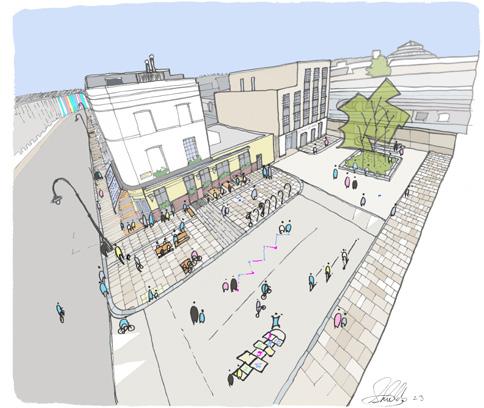
Over twelve years ago, the Primrose Hill Conservation Area Advisory Committee asked Camden if Dumpton Place – the cul de sac adjacent to The Lansdowne pub – could be refurbished, with ideas for its design to come from the Committee and its architect members. There was approval from Camden for this cooperation, but the negotiation process dragged on for a full twelve years.
Now that the refurbishment is complete, local residents can see a tree grove with three trees – two silver birches and one alder –and underplanting; an entry table treatment to discourage cars from turning in; rebuilt Victorian kerbs and steps against the historical railway wall; fewer parking places; and new footways and bike racks.

There is still progress to be made on the removal of all waste bins from Dumpton Place − belonging to both the pub and residents –and to persuade Network Rail to restore the condition of the wall by repointing. But the improvements made in this small area are considerable, and a triumph of patience and persistence.

By Jeremy Lewison

The Fellows Singers, one of Primrose Hill’s chamber choirs, is embarking on a new chapter of its history with the appointment of Jonathan Darbourne as its new Music Director. Founded in 2017, its first Music Director, operatic tenor Bradley Smith, progressed it into a lively, friendly group of singers willing to take on a wide variety of music. While there may be a few changes under Jonathan, the range of music will be the same.
Jonathan first began singing as a treble at Southwark Cathedral. As a young boy he sang the part of Miles in Elijah Moshinsky’s production of Benjamin Britten’s The Turn of the Screw. After dropping down to baritone, he discovered he had a talent for the part of countertenor, and it is as countertenor that he now performs. A choral scholarship to Magdalen College, Oxford, led him to develop a wide repertoire under Bill Ives, a former King’s Singer, and Jonathan himself formed the Oxford Clerks. After Oxford he studied at the Schola Cantorum in Basel, and once back in London he joined the Temple Church choir. He has also brought together groups of singers to record music for films and television, including for Bridgerton and The Crown. Jonathan’s interests are wideranging: just as much at home with Golden Era jazz as with the classical repertoire.
In 2020 he and Betty Makharinsky established Vache Baroque, initially to produce Baroque opera with a contemporary twist outdoors in the grounds of the historic house, The Vache, in Chalfont St Giles (45 minutes on the Metropolitan Line from Finchley Road Station). The first production was Purcell’s Dido and Aeneas, and this year’s was Pergolesi’s L’Olimpiade
Healthy foods for a healthy mood 8am – 7.45pm every day 140 Regent’s Park Road Primrose Hill, London NW1 8XL 0207 722 2947 www.bensgrocers.com
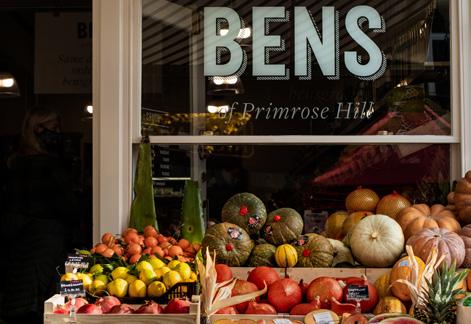
But the Vache Baroque Singers have also performed concerts at St John’s Smith Square and on BBC Radio 3. In April 2025 he will conduct Rossini’s La Cenerentola (Cinderella) for Hampstead Garden Opera at Jackson’s Lane. It is an incredible coup for the Fellows Singers to have such an accomplished Director of Music.
While Jonathan loves producing, or what is called ‘fixing’ (assembling groups of singers, programming, directing), equally important for him is the outreach programme that he and Betty run in state schools. “The more you do outreach as a professional, the more you realise you contribute to the happiness of people and their well-being,” he believes.
For Jonathan, who lives in North London, the Fellows Singers is another form of outreach where he can share his talent. Having deputised for a term for Bradley, he knows some of the singers already. “They are a lovely group of people and I am looking forward to getting to know them better. The social aspect is another important feature of the group. Singing is a social activity; it builds confidence, team and leadership skills.”
Jonathan will be writing new arrangements for the choir, and wants the Fellows Singers to work with an instrumental ensemble at some point. “I have ambitions to increase the number of soloists within the choir – there are already four or five who regularly perform solos at concerts – and to programme closed solo sessions.”
There will be three free concerts a year that take place in St Saviour’s Church, Eton Road. The Fellows Singers also perform there in the Carol Service in December. It is a choir connected to the local community and welcomes new singers. At the moment a group of ten, Jonathan would like to grow it to sixteen. So if there are any singers who would like to come along and try it out, they are welcome to do so.
www.fellowssingers.com vachebaroque.com

To celebrate Primrose Bakery’s 20th year in Primrose Hill, they’ve sent On The Hill a delicious rainbow layer cake recipe.
Congratulations on your anniversary!
Ingredients
Sponge
450g golden caster sugar
420g self-raising flour
50g cornflour
2 tsp baking powder
450g unsalted butter
8 large eggs
2 tsp vanilla extract
6 tbsp milk
Blue, lilac, green, yellow and pink food colours
Icing
170g unsalted butter
90ml semi-skimmed milk
1½ tsp vanilla extract
750g icing sugar
To decorate: multicoloured sprinkles
Method
1. Preheat the oven to 180°C/160°C fan.
2. Grease the bottom and sides of the tins thoroughly, then line the base of each tin with greaseproof paper.
3. Put all the dry ingredients into a large mixing bowl and stir to mix fully. Add in all the wet ingredients and beat together well, using an electric hand-mixer, until fully combined.
4. Divide the batter evenly between the five smaller bowls, then add one of the colours to each bowl, making sure it is mixed through thoroughly – for the yellow, pink and green bowls use a ¼ tsp of colour, and for the blue and lilac bowls use an ⅛ tsp of colour.
5. Put each batter into a separate tin (this may need to be done in stages – see box).
6. Bake in the middle of the oven for 20 minutes or until a skewer inserted in the centre of the sponge comes out clean.
Makes one 8” layer cake (10−12 portions).
You ideally need five small bowls plus five 8” sandwich tins with removable bases. If not, you can make the layers in relays, cleaning the bowls and tins between uses.
All ingredients should be at room temperature before starting, and the finished cake should be stored at room temperature.
Leave in the tin for 10 minutes and then turn out to cool fully. Repeat this stage with the other batters if necessary.
7. To make the icing, mix the vanilla extract and milk together in a jug. In a large bowl beat this mixture together with the butter and half the icing sugar until smooth. Gradually add the remainder of the icing sugar and beat again until the buttercream is smooth and creamy.
8. To assemble the cake, place the purple layer of cake on a board, and use a pallet knife to spread a layer of icing on top, repeating with the blue, green, pink and finally the yellow layers. Next, ‘crumb coat’ the cake by spreading some icing thinly all over the top and sides, right down to the bottom. Put the cake in the freezer (or fridge) for 5 minutes to set the icing. Then ice the whole cake again, tidying it up to get the desired finish, and decorate the top with sprinkles.
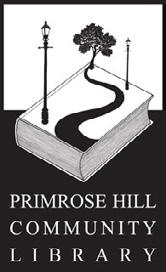
Polly Toynbee and Andrew Marr
Discuss her memoir, An Uneasy Inheritance
Hadley Freeman In Conversation
Francesca Segal In Conversation
On her new novel, Welcome to Glorious Tuga
Petroc Trelawny with Nicholas Crane 11am Cornwall, Journeys & Travel Writing
Nicholas Hytner with David Hare 1pm The State of Theatre
By the Mole On The Hill

by Sarah Louise Ramsay


CALL US TO BOOK A CONSULTATION ON 02032042020 OR EMAIL AT INFO@NUYULONDON.CO.UK

Offering
Laser Hair Removal
Doctor Led Aesthetics
Profhilo
Polynucleotides - NEW!
Microdermabrasion
Chemical Peels
NIR Skin Tightening
Medik8 & Obagi
Skincare And More...
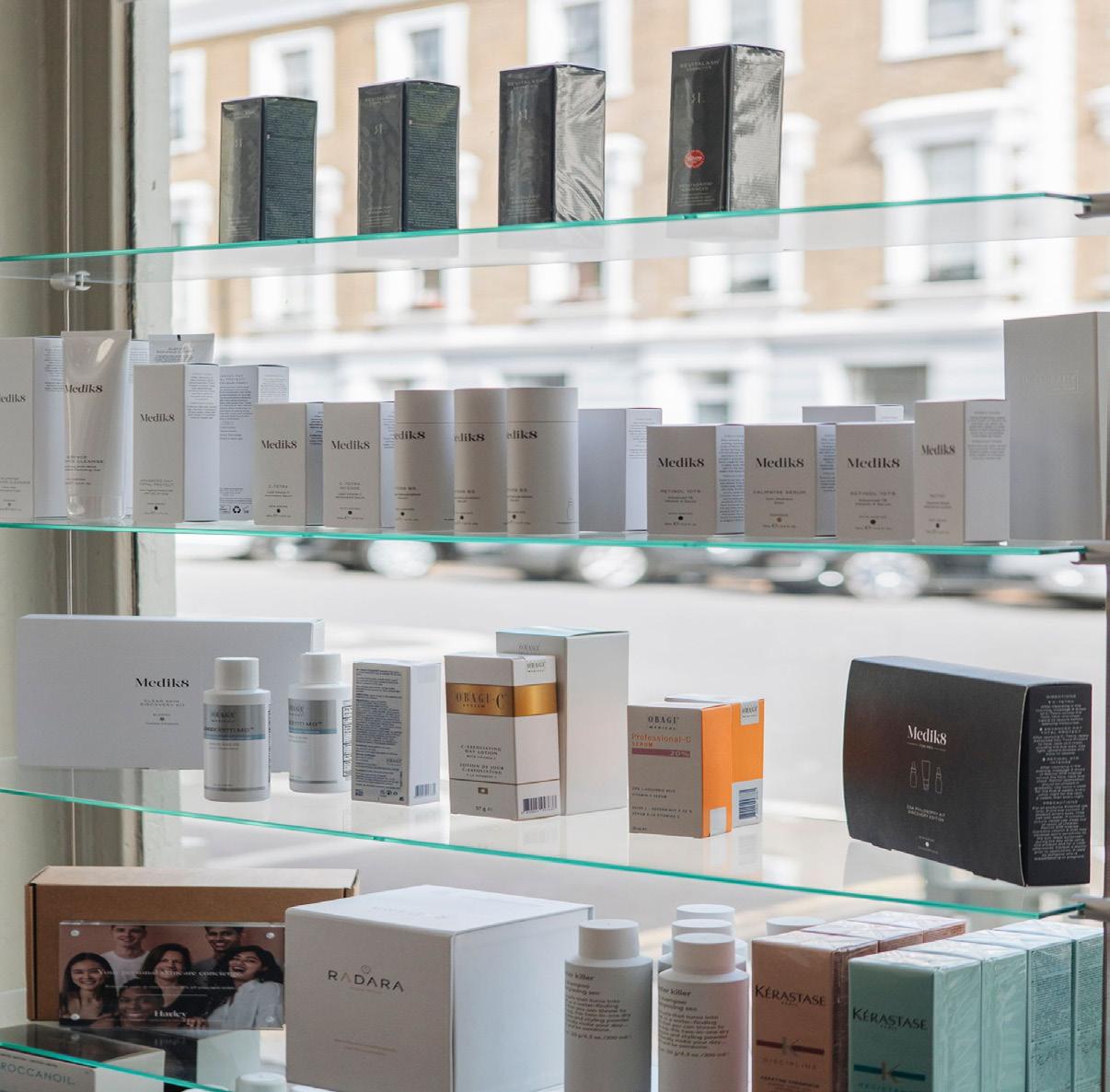
In response to Martin Sheppard’s article, Primrose Hill Open and Shut (OTH June 2024) about the history of gates in Primrose Hill, Caroline Cooper sent us this photograph. It shows Caroline, arguably Primrose Hill’s most longstanding resident, as a child outside 68 Regent’s Park Road in the late 1940s. Note the family car parked outside; there were few cars on the roads at that time. Her father must have taken this photo from Primrose Hill, where there were clearly no railings.

Dom joined the Primrose Hill Community Association as an administrator for the Community Centre in September 2021. She immediately and effortlessly took over all admin duties, membership, newsletters, social media, bookings and the website, and built up excellent relations with the many visitors the Community Centre gets on a daily basis.

She remained a bit of a hidden treasure until the Primrose Hill Community Library suddenly had a vacancy. As Dom is a trained librarian holding a master’s degree in librarianship, coupled with the glowing reports she’d picked up at the Community Centre, it was a no-brainer that she was offered the job of librarian. She therefore took on a double role, at the Library as well as her Community Centre responsibilities.
Of course, now she was in her natural library habitat she blossomed, with all staff, volunteers and members of the public taking to her instantly because of her calm, levelheaded and efficient way of working. A member of the Book Committee wrote: ‘‘Dom was an extremely wellinformed and efficient librarian and contributor to the Library Book Committee. She was full of good ideas. She devised new displays, like that of authors’ birthdays month by month, and rearranged sections of the Library to better suit the stock.
Her conspicuous, clear new labels on the back of books are a help for volunteers and readers. We shall try to follow the example she has set for us.”
We always knew we could only have her for a limited time, as she would always have to think of her career. Sadly for us, but excitingly for her, she left us at the end of September to take up the role of Metadata and Discovery Assistant for Bloomsbury Publishing. We wish her all the luck in the world with her future career and her newly married life. Her work with PHCA has been outstanding, and Dom knows she will always receive a very warm welcome at both the Community Centre and the Library.
We now have a Dom-sized vacancy to fill, which will not be easy!

Thank you to Ian Shaw for sending this amazing June sunset on Chalcot Road and the eerie orange cloud formations.
If you have any photos of the area which you’d like to share, please send them to editor@onthehill.info for possible inclusion in our next issue.









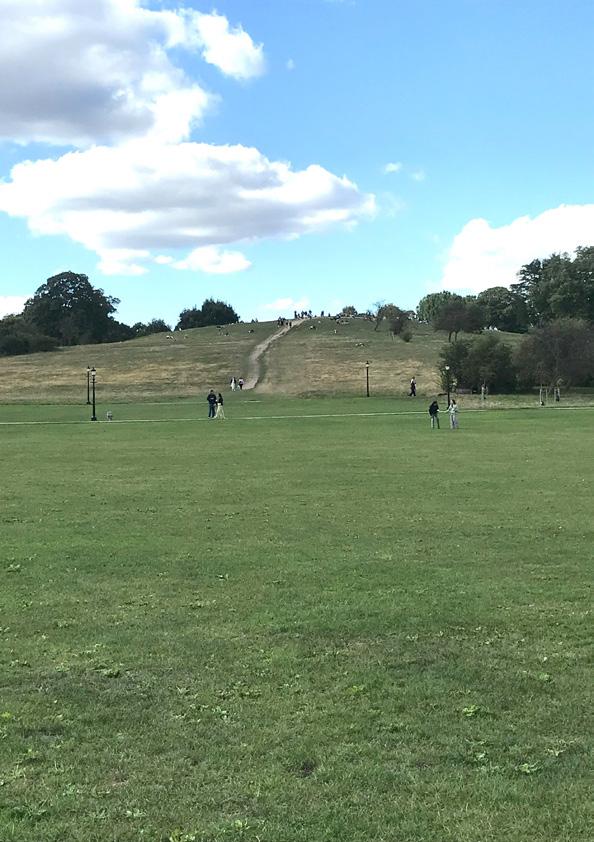
By Howard Richards
The Primrose Hill Summer Garden Party was held in Chalcot Square in June. Hosted by the Primrose Hill Community Association, there was live music, tea and cakes, Pimm's, children’s activities, a raffle and best mask competition. Thank you to all the donors for their contributions, the artists for giving their time, and all the volunteers.
Photography by Sarah Louise Ramsay, Tara Kirwan, John Nutt and Jason Pittock. More images from the event can be seen at onthehill.info/pics








